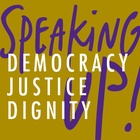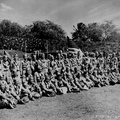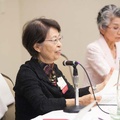Introduction
This presentation will use the tanka, haiku, and senryu poems of the first generation of Japanese immigrants to Hawaii to trace the changes in their consciousness as Japanese, their loyalty to their homeland, and their assimilation into America, the land they migrated to. The period covered will be the 20 turbulent years from the Manchurian Incident in 1931, through the Pacific War, to the San Francisco Peace Treaty coming into effect in 1952.
During this time, the legal and social status of the Issei underwent great changes. Before the war, Japanese immigrants had no right to naturalization, and the Issei were Japanese with Japanese nationality, but they had decided to settle in Hawaii and raised their children, the Nisei, as Americans. With the outbreak of war between Japan and the United States, the Issei became "enemy aliens," and while their pride and culture as Japanese were suppressed, they declared their allegiance to America and sent their sons to serve in the U.S. military. After the war, the Issei were devastated by Japan's defeat, but with the passage of the McCarran-Walter Immigration and Naturalization Act in 1952, they were granted their long-desired right to naturalization, and acquired American citizenship.
An analysis of the literary works of the Issei reveals that throughout their time, their love for their homeland changed but was maintained, and that Japanese culture and values were preserved. The Issei immigrants maintained a dual identity with Japan and America, though in different forms, before, during, and after the war. Because of this duality, the war tore the hearts of the Issei apart. Even during the war, the Issei continued to write down their daily feelings in tanka and haiku. Writing poetry was one way for them to maintain their dignity as human beings.
This time, I would like to use the literary works of the Issei - tanka, haiku, and senryu - as historical materials to interpret their thoughts, actions, and emotions.
1. 1930 Sino-Japanese War
When the Second Sino-Japanese War broke out, many first-generation Japanese in Hawaii were thrilled by the news of the Japanese invasion of the continent and felt proud of the "Imperial Japan." Wanting to know the state of the war, the immigrants glued themselves to Japanese newspapers and shortwave radios from Tokyo. And, sympathizing with the Japanese soldiers in mainland China, they sent donations and comfort bags to their homeland. The number of groups visiting their homeland also increased.
The autumn night continues as the radio reports the war situation.
When I turned sixty and entered a major battle, my courage rose up.
There are people who go there to console the spirits of fallen warriors. Today, there are flowers on the boat.
As relations between the United States and Japan became strained and the Treaty of Amity and Commerce between the United States and Japan was abolished in 1940, immigrants felt uneasy with the prospect of war between the United States and Japan.
Spring thunder strikes Japan, and Japan is finally free of treaties (abolition of the trade treaty) by Shosei Yokoyama
Following the summer, radio waves of a declaration of war fly wildly.
2. December 1941: The surprise attack on Pearl Harbor and the start of the war
The surprise attack on Pearl Harbor came as a bolt from the blue to all Hawaiians. They could not believe it and thought it was a US military exercise. On the day the war began, the Territory of Hawaii was placed under military rule. Blackouts and curfews were immediately imposed. The Issei leaders were arrested and interned in internment camps (less than 1% of the Japanese population was interned). The Issei were confused as to how to respond to this shock.
Something that should never have happened occurs, and a war between the Land of the Sun and the Land of the Stars begins.
We were shocked when the broadcast of the attack on Pearl Harbor was announced.
As I see my husband off as he is arrested, the white and blue lighted car disappears into the darkness.
The Issei were made "Proper Foreigners." Due to fears of espionage, the Issei were prohibited from owning cameras and radios. The use of Japanese in public was prohibited, as was gathering with more than ten Japanese people. Personal letters were censored and telephone calls were wiretapped. As expected, the Japanese community was in turmoil, but the Hawaiian military government guaranteed that Japanese people would live a life that was basically the same as everyone else's. Gas masks were also distributed equally to everyone. The Issei expressed their torn identities in poetry, maintaining a sense of humanity.
Enemy, alien, those names weigh on me even in my dreams
Nakabayashi Muyu
GASMASK Instead of a camera, Spring Town by Shosei Yokoyama
The Issei's sense of Japanese identity and their pride as Yamato people were not likely to change easily. In 1942, the first New Year after the outbreak of war, the Issei in Hawaii celebrated New Year's Day as Japanese people, just as they had done up until that point.
The first light of the fireball of a hundred million people (welcoming the new year under martial law in 1967) by Shosei Yokoyama
Kadomatsu and questions are also Japanese people by Shosei Yokoyama
The Issei in Hawaii could feel the war situation from the movements of battleships and gun carriages. The Issei's feelings for Japan are expressed in their songs.
Ships Rushing to and from the Island - Winter Thunder by Shosei Yokoyama
Guns are coming after guns through the city, Japan is being cornered.
*This is the manuscript of a presentation given in the Japanese session " Issei Poetry, Issei Voices " at the Japanese American National Museum's nationwide conference " Speaking Up! Democracy, Justice, Dignity, " held from July 4 to 7, 2013.
Listen to this session's presentation (audio only) >>
© 2013 Noriko Shimada













